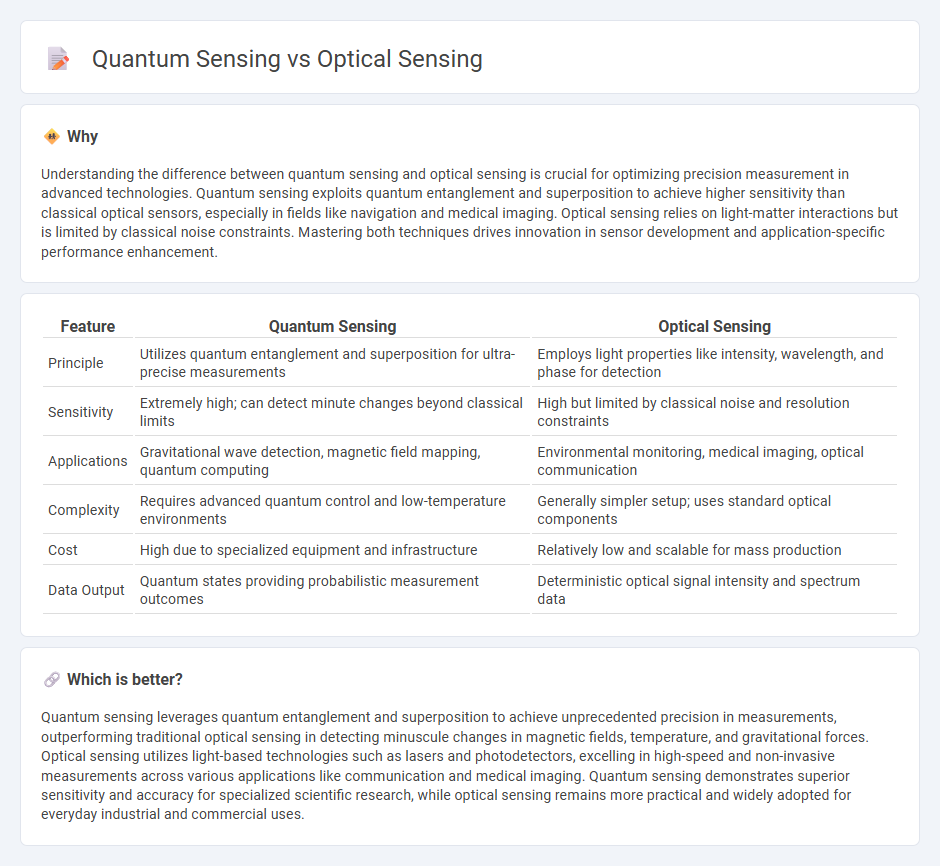
Quantum sensing leverages quantum mechanics principles to achieve unprecedented sensitivity and precision in measuring physical quantities such as magnetic fields, temperature, and time. Optical sensing relies on light interactions to detect changes in the environment, offering high resolution and real-time monitoring capabilities. Explore the latest advancements and applications to understand how these sensing technologies are transforming industries.
Why it is important
Understanding the difference between quantum sensing and optical sensing is crucial for optimizing precision measurement in advanced technologies. Quantum sensing exploits quantum entanglement and superposition to achieve higher sensitivity than classical optical sensors, especially in fields like navigation and medical imaging. Optical sensing relies on light-matter interactions but is limited by classical noise constraints. Mastering both techniques drives innovation in sensor development and application-specific performance enhancement.
Comparison Table
| Feature | Quantum Sensing | Optical Sensing |
|---|---|---|
| Principle | Utilizes quantum entanglement and superposition for ultra-precise measurements | Employs light properties like intensity, wavelength, and phase for detection |
| Sensitivity | Extremely high; can detect minute changes beyond classical limits | High but limited by classical noise and resolution constraints |
| Applications | Gravitational wave detection, magnetic field mapping, quantum computing | Environmental monitoring, medical imaging, optical communication |
| Complexity | Requires advanced quantum control and low-temperature environments | Generally simpler setup; uses standard optical components |
| Cost | High due to specialized equipment and infrastructure | Relatively low and scalable for mass production |
| Data Output | Quantum states providing probabilistic measurement outcomes | Deterministic optical signal intensity and spectrum data |
Which is better?
Quantum sensing leverages quantum entanglement and superposition to achieve unprecedented precision in measurements, outperforming traditional optical sensing in detecting minuscule changes in magnetic fields, temperature, and gravitational forces. Optical sensing utilizes light-based technologies such as lasers and photodetectors, excelling in high-speed and non-invasive measurements across various applications like communication and medical imaging. Quantum sensing demonstrates superior sensitivity and accuracy for specialized scientific research, while optical sensing remains more practical and widely adopted for everyday industrial and commercial uses.
Connection
Quantum sensing and optical sensing are interconnected through their reliance on quantum properties of light, such as superposition and entanglement, to achieve high precision measurements beyond classical limits. Optical sensors utilize photons to detect changes in physical parameters like temperature, pressure, and magnetic fields, while quantum sensors enhance sensitivity by exploiting quantum coherence and interference effects. This synergy enables advancements in fields like biomedical imaging, navigation, and environmental monitoring by providing ultra-sensitive and accurate detection capabilities.
Key Terms
Photodetector
Photodetectors in optical sensing convert light into electrical signals using semiconductor materials, enabling applications such as imaging, environmental monitoring, and telecommunications with high sensitivity and speed. Quantum sensing photodetectors leverage quantum properties like superposition and entanglement to achieve ultra-high precision and sensitivity beyond classical limits, critical for advanced fields like quantum computing and secure communication. Explore the cutting-edge advancements and comparative performance metrics of optical and quantum photodetectors to understand their technological impacts.
Superposition
Quantum sensing leverages superposition to measure physical quantities with unprecedented precision by exploiting the simultaneous existence of multiple states, enhancing sensitivity beyond classical limits. Optical sensing, while highly effective, relies mainly on classical light properties such as intensity and wavelength, lacking the quantum advantage provided by superposition. Discover how superposition transforms sensing technologies and unlocks new potentials in measurement accuracy.
Sensitivity
Optical sensing relies on the detection of changes in light properties such as intensity, phase, or wavelength, offering sensitivity levels suitable for many industrial and environmental applications. Quantum sensing leverages quantum phenomena like entanglement and superposition to achieve sensitivity beyond classical limits, enabling detection of exceptionally weak signals or small changes in physical parameters. Explore deeper to understand how quantum sensing surpasses traditional optical techniques in precision and performance.
Source and External Links
What are optical sensors and what are they used for? - Optical sensors are devices that detect light intensity and convert it into electrical signals, enabling non-contact, fast, and wide-range measurements in industries such as manufacturing, food, and pharmaceuticals.
What are Optical Sensors Used For? - Optical sensors detect and measure light by converting it into electrical signals, using sources like LEDs and lasers, and are applied in computers, motion detectors, and various industrial systems depending on the material and application.
Electro-optical sensor - Electro-optical sensors convert light or changes in light into electronic signals, detecting electromagnetic radiation from infrared to ultraviolet, and are used in automatic lighting, position sensing, flash synchronization, and object detection.
 dowidth.com
dowidth.com